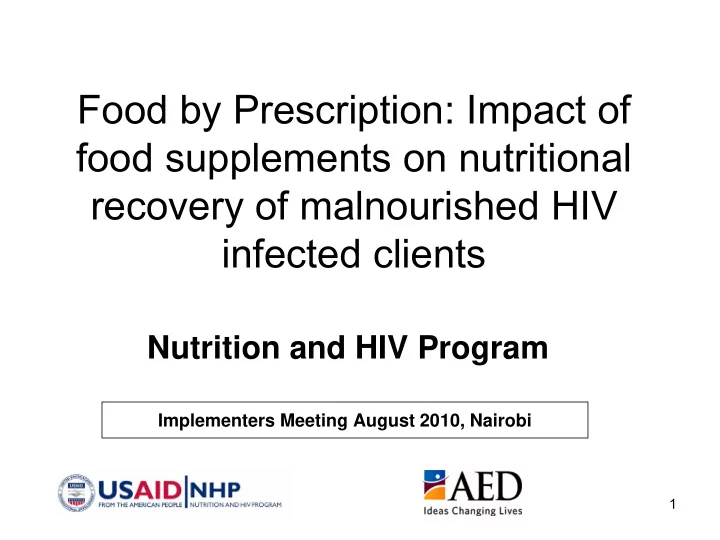

Food by Prescription: Impact of food supplements on nutritional recovery of malnourished HIV infected clients Nutrition and HIV Program Implementers Meeting August 2010, Nairobi 1
• This presentation will cover… • Reflections on significance malnutrition in management of HIV infected; • Treatment options and rationale for feeding regimens; • Experiences from operations research and in service delivery; • Conclusions and opportunities for the future 2
Pathophysiology of malnutrition in HIV infection Modified metabolism – increased resting energy expenditure, increased protein degradation, peripheral lipolysis (re-cycling fatty acids), impaired organ function Inadequate food intake – food insecurity , anorexia, pain, physical impairment, neurological impairment Gastrointestinal disorders - Impaired digestion, malabsorption and intestinal permeability/gut loss. Reduced physical activity (due to constitutional symptoms) - disuse atrophy. Interference with androgenic hormone production. 3
Treatment Options – Adjunct to HAART • Nutritional – Nutrient dense supplemental and therapeutic foods + anti-oxidant micronutrients (vitamins and minerals) • Resistance exercises – progressive resistance exercise training • Hormone therapy – Anabolic compounds • Cytokine – Blockers (TNF- α ) Most Feasible ► Nutritional + resistance exercise 4
Aim of nutrition treatment in PLHIV Improve Quality of Life; Restore function Reduce morbidity Slow disease progression Reduce stigma Improve adherence to medications (ARVs) & lower drug toxicity Reduce mortality 5
Supplemental and Therapeutic Feeding Regimens Fortified Blended Food – Pre-cooked flour • Energy dense foods: Whole grain cereal flour + Fat • Essential amino-acid + Non-EAA: Soya ~ L- glutamine, L- arginine • Multiple micronutrients (MM): Anti-oxidants - Se, Zn, Vit E,C; Ready to Use Therapeutic Food (RUTF) • Spreads: Peanuts-lipid paste + Milk powder + MM + Sugar Combination of FBF + RUTF 6
Food Products Approx. ~US$ 0.29/meal or Ksh 18.50; (US$ 1.01/kg. or US$ 0.23/1,000 kcal) FBF RUTF 7
Effectiveness of FBP in treatment of malnutrition in PLHIV Ndeka MJ et Patients with BMI < 18.5 starting ART al 2009; Supplemented with energy dense peanut- Malawi lipid based spread vs corn-soy blend for 14wks; Rapid wt gain in 1 st 2 wks. BMI increase 2.2 + 1.9 vs 1.7 + 1.6; No obvious effects on mortality at 3.5 mo (26% vs 27%) Muttunga FBF supplement + nutrition counseling vs JN et al nutrition counseling alone on malnourished 2010; Kenya adult patients starting ART & pre-ART. Wt gain 1.9 & 1.0 kg in 1 st mo and 4.6 & 3.4 kg (FANTA/ by 3 rd mo on food & non-food respectively KEMRI) 8
Evidence? FBF vs. No Food for HIV+ Adults:Results: BMI ( ART ) • Differences significant through the 3 rd month. • Food significant determinant of BMI at 3 months in multivariate regression but not 6. • Greater difference for women than men. • Rapid weight gain: 1.9 & 1.0 kg in 1 st month and 4.6 & 3.4 kg. by 3 rd month on food & non- food respectively . 9 FANTA & KEMRI, 2010
Evidence?; FBF vs. No Food for HIV+ Adults: Results: BMI ( pre-ART ) • Differences significant through the 6 th month. • Food significant determinant of BMI at 3 and 6 months in multivariate regression. • Greater difference for women than men. • After 6 months differences not significant (n quite low by then). 10 FANTA & KEMRI, 2010
Experiences from NHP • Sub ‐ sample of data drawn from 292 primary and satellite sites during the period January – June, 2010 • Clients with 2 consistent follow ‐ up visits after baseline were selected • Estimated changes in weight and BMI 11
Profiles of clients enrolled Jan-June 2010 (n=17,065) • Gender distribution Male=33.3%, Female=66.1% • Mean Age: M ale=39.84(SD=12.75),Female=35.84(SD=21.61) • Pre – ART = 48.4%, ART = 51.6% ART Status: • Mean Overall Treatment time: 62.7 days • Clients on TB treatment : 16.1% (72% reporting) 12
BMI Profile of beneficiaries Pre ART ART BMI Category Number % Number % (kg/m 2 ) 1918 27.5 1535 21.7 < 16 1398 20.0 1275 18.1 16 - 17 2500 35.8 2694 38.2 17 - 18.5 1158 16.6 1557 22.1 18.5 – 21.9 6974 100.0 7061 100.0 Total *p<0.005 between Pre ‐ ART and ART groups 13
Mean weight and BMI changes for a sample of clients Category Indicator Response % Clients Mean (IQR) Gain 76.8 3.7 (1.5,5.0) Weight (n=358) Loss 23.2 -3.0 (-4.0,-1.0) Pre-ART Gain 73.1 1.09 (1.23,1.5) BMI (n=546) Loss 26.9 -1.04 (-1.4,-0.4) Gain 73.2 3.7 (1.4,5.0) Weight (n=937) Loss 26.8 -2.93 (-4.0,-1.0) ART Gain 72.6 1.1 (0.3,1.6) BMI (n=1452) Loss 27.4 -1.15 (-1.5,-0.4) Age: Comparable to the cohort; Nutrition profile: similar to the cohort 14
Percentage weight change among clients % weight Pre ART ART change Number % Number % < 10% 280 78.2 746 79.7 > 10% 78 21.8 190 20.3 Total 358 100.0 936 100.0 15
Conclusions • The NHP findings are similar to those reported in the Kenyan OR study; • The reported weight gains did not attain the 10% threshold (~ assumed nutrition reconstitution threshold); Longer supplementation period/improved adherence required. • Strengthening nutrition education and counseling, improve client follow-up mechanisms and data quality assurance 16
Future 1: Fully Mainstream Nutrition services in care & treatment – Action Points • Alignment – include adult height & BMI in the BLUE CARD and Reporting • Integrate Nutrition Services in Strengthening Data Quality Assurance in • Demystify nutrition care and integrate in pre and in-service training • Provide Intensive Nutrition Counseling at first contact & reinforce in follow-up contacts + IEC materials; • Strengthen the fight against stigma 17
Additional Opportunities • Future 2: Improve knowledge and capacity to manage gut health • Future 3: Improve FBP regimens + Targeted Cytokine Blockers • Future 4: Include inflammatory burden assessment – key Acute Phase Proteins in patient assessment 18
Acknowledgments MMS & MPHS- NASCOP Insta Products Ltd Participating sites Partners: APHIA II Nyanza, Coast, CDC, CRS, ICAP USAID/K 19
Recommend
More recommend